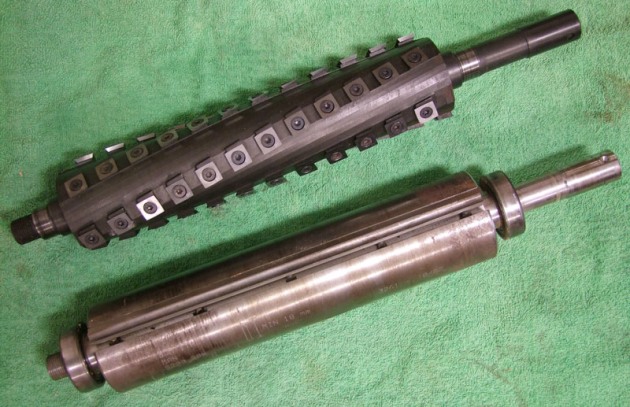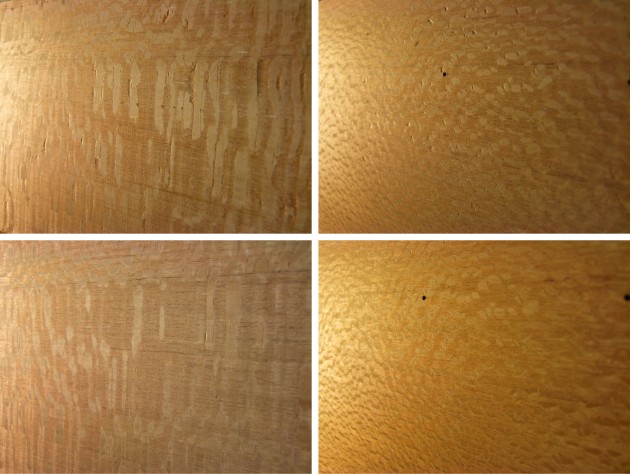Upgrading to a spiral cutterhead
1. Shelix Byrd spiral cutterhead ready for retrofitting up top, with straight knife below.
Review and photos: Troy McDonald
Spiral or segmented cutterheads can be retrofitted to the standard straight knife cutterblock that has been in use on planers for generations. Photo 1 shows Shelix spiral cutter obtained from Woodcraft Supplies along with the straight knive cutterblock it replaced.
Advantages of spiral cutterheads
Small carbide cutters within the cutterblock present a shearing cut to the timber which is claimed to have three advantages over straight knife cutters: reduced noise, improved cut quality and quicker, more accurate blade changes.
1. Noise reduction. Users of planers with conventional straight knife cutters will know the loud whine that these machines develop. This noise, often amplified by dust extraction, results from the high speed rotating knives compressing air as they rotate past the infeed tables and internal chip baffles. With segmented cutterheads, the change in blade geometry and reduced length of the individual cutters theoretically results in a significant reduction in air compression and noise.
2. Cut quality. Finish quality on straight knife cutters depends on the number of knives located within the cutterhead and the feed speed of the timber. On figured material the straight approach of the cutters is prone to producing tear out. By contrast, the helical arrangement of cutters within a segmented head produces a shearing action with obvious benefit.
The downside is that the individual segments need to be in perfect alignment to avoid the development of lines running the length of the board. Precision manufacture is therefore required to produce a quality cutterhead that avoids this problem. Of course the other variable affecting quality of finish is sharpness of the cutters. Whilst high speed steel conventional cutters are capable of a much sharper edge than carbide, the superior edge retention of carbide cutters means the tungsten material will typically present a sharper edge to the material being worked for a much longer time.
3. Quicker knife changes. Because they dull more quickly, high speed steel knives require relatively frequent sharpening and this requires the knives to be removed from the head. Repositioning the knives following sharpening is a job I love to hate
and although there are a host of jigs and techniques which contribute to making this job easier and more accurate, for me it remains a tedious task.
Segmented cutters require less frequent sharpening and when they do it is a simple process of loosening the individual cutters and rotating them a quarter turn to expose a fresh edge. Similarly, if you work recycled timber, an impact from a nail will typically require rotation of only one or two cutters. In a conventional head you would need to resharpen all knives or slide one of the knives along the head to ensure any damaged sections are not in alignment.
Availability
Segmented cutters have risen in popularity in recent years and are now available as standard or options on many machines. For those with existing machines there are a number of retrofits available. All my machining tasks revolve around a SCM Minimax CU300 combination machine and after some research I decided to retrofit a Shelix spiral cutter planing head from Woodcraft Supplies to my machine. The cost will vary according to machine so you will need to get a quote.
With an over and under style planer/thicknesser like mine, the upgrade effectively provides you with the advantages of a helical head for both planing and thicknessing operations. If you have separate machines, then it should be the thicknesser that receives the upgrade given this is where most boards are finally dressed.
Installation
There are a number of good sources of information on the web detailing how to upgrade machinery of both American and Taiwanese manufacture, however, I failed to find any information specific to European machinery. After receiving some advice from the Minimax distributor I found the upgrade relatively trouble free.

2. Basic tooling needed to effect the upgrade. Engineering drawings are critical.
Don’t attempt the change-out without at least an engineering drawing of your machine which again you should be able to source from your distributor. The basic tooling required for the change-out is shown in photo 2 and the basic steps required to complete the upgrade specific to my machine are shown in photos 3–6.

3. Disconnect the source of power and the drive belt.
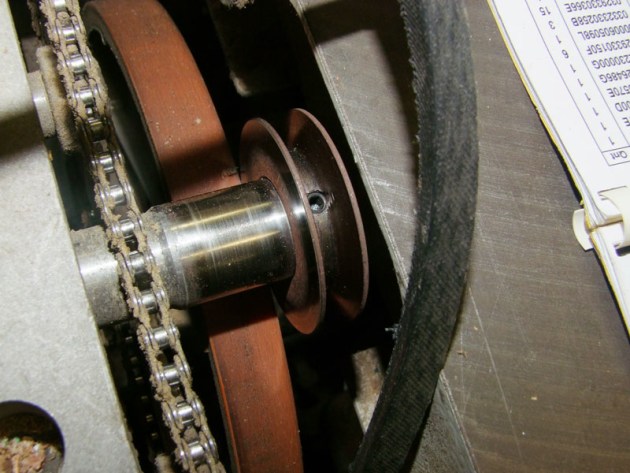
4. Ensure parts to be removed are marked in position and photographed. You’ll thank yourself during reassembly.
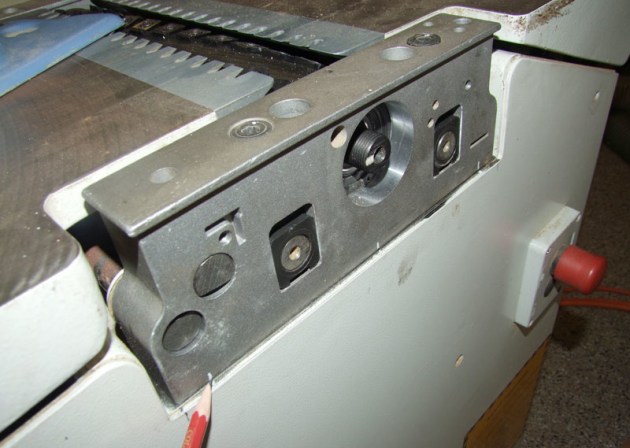
5. Wrap old and new cutterheads to protect your hands. Unbolt and remove the bearing tower to allow cutterhead removal. Take care to note positions of tensioning springs for infeed and outfeed rollers prior to removal.

6. Keep notes as you go and store parts as they come off the machine in a logical order on a clean bench.
The results
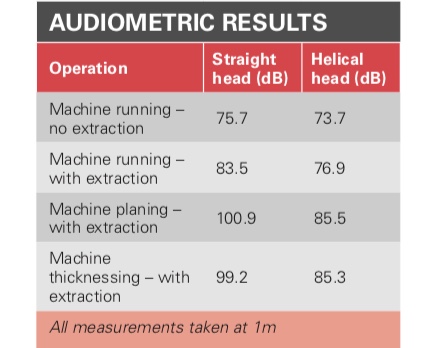
The table summarises the sound reduction that resulted from the upgrade. Remember that the dB scale for sound measurement is not linear and as such every 10dB increase in sound corresponds to ten times the sound intensity. The measurements confirm that decrease in sound is significant and very noticeable.
Top left: Quarter-cut silky oak off the planer with standard straight knife cutters. Tear out is evident.
Top right: The reverse side of the same board fresh from the thicknesser. Better, but tear out remains.
Bottom left: The improved finish from the segmented head is significant in planing mode.
Bottom right: Thicknessing also shows a major improvement over the standard head.
As for surface finish, I tried both cutting heads on a piece of quartersawn silky oak, a timber which can be prone to tear out across the medullary rays. The photos above show the results. The improvement in finish was again quite significant.
Is it worth it?
I personally put off upgrading for many years as I struggled to justify the cost. It was the potential reduction in noise that finally forced me to act and I’m pleased I did. The improvement in surface finish is also a considerable advantage for those that work with figured timber. In the end, the justification for upgrading will be very specific to your own application.
For many the upgrade would still be seen as an indulgence, however, in my workshop situation the reduced noise justifies the purchase price alone.
Troy McDonald is a Brisbane based engineer and woodworker who writes regularly for Australian Wood Review magazine.
Shelix Byrd spiral cutterheads available from Woodcraft Supplies, phone 07 4129 4644 or 0418 184 048
Learn more at www.wizardproducts.com.au



